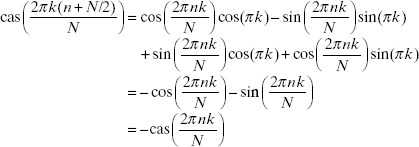E
Fast Hartley Transform
Whereas complex additions and multiplications are required for an FFT, the Hartley transform [1–8] requires only real multiplications and additions. The FFT maps a real function of time into a complex function of frequency, whereas the fast Hartley transform (FHT) maps the same real-time function into a real function of frequency. The FHT can be particularly useful in cases where the phase is not a concern.
The discrete Hartley transform (DHT) of a time sequence x(n) is defined as
![]()
where
![]()
In a similar development to the FFT, (E.1) can be decomposed as
![]()
Let n = n + N/2 in the second summation of (E.3)
![]()
Using (E.2) and the identities
![]()
for odd k

and, for even k
![]()
Using (E.6) and (E.7), (E.4) becomes
and
Let k = 2

